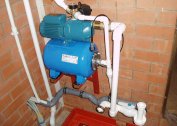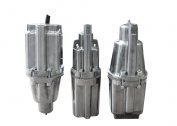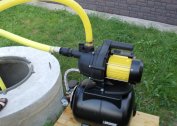Water sources are objects of strategic importance, since the life and health of the country's population depend on the quality of water. The protection of the safety of natural resources is guaranteed by the Constitution of the Russian Federation, is the state’s concern and is provided by the sanitary rules and regulations of SanPiN of the sanitary protection zone of water supply sources and drinking water supply systems. Sanitary Protection Zone (ZZO) is a site with a special land use regime. It stands out around the places of water intake and transportation to create a barrier against industrial pollution, toxic substances, pathogens.
ZSO belts and boundary definition

To ensure the environmental safety of facilities around drinking water wells or a water conduit connecting the water intake to the main water main, adjacent sections are allocated that pass through a strip along the buildings.
Calculating the width of the ZZO belts for the source of water intake, they rely on the following parameters:
- type of source: surface, deep-underground;
- hydrological conditions and phases of the water regime: high water, low water, seasonal or rain floods;
- geological conditions: relative position of water-resistant and aquifers;
- topography;
- climatic conditions: temperature, wind rose, amount of precipitation;
- type of pollution: bacteriological, chemical.
In accordance with the norms (SanPiN 2.1.4.027-95), the ZSO is divided into several zones characterized by security measures with varying severity of regime.
Strict regime - fenced guarded territory
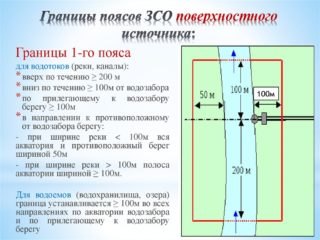 First belt ZSO - designed to protect the source, water intake point, water supply system from intentional or unintentional pollution or accidents. The water disposal zone should be located outside the residential zone of settlements, as well as outside the territory of industrial enterprises. The security belt is organized in the form of a circle with a diameter of 30 m to 50 m, in the center of which there is a water source.
First belt ZSO - designed to protect the source, water intake point, water supply system from intentional or unintentional pollution or accidents. The water disposal zone should be located outside the residential zone of settlements, as well as outside the territory of industrial enterprises. The security belt is organized in the form of a circle with a diameter of 30 m to 50 m, in the center of which there is a water source.
If there are several wells, the extreme one is taken as the reference point of the boundary. For protected sources, where the aquifer adjoins two water-resistant reservoirs (for example, artesian waters), in agreement with Rospotrebnadzor, the size of the first belt can be reduced downward if there is an expert opinion on the zero probability of surface pollution.
In the case of unprotected sources, where groundwater is present, above which the soil does not have water-resistant properties or there are hydrogeological windows in the upper water-resistant layer, the maximum possible sanitary protection zone is set up. This is due to the fact that such sources are fed with surface water, into which impurities can easily enter.
If underground reservoirs are replenished through artificial canals, the security belt can increase to 150 m.
Restriction regime - unenclosed territory indicated by signs
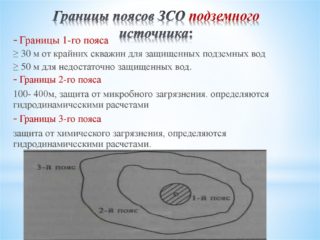 Second belt - zone of counteraction to microbial contamination. The size reaches 3-5 kilometers from the water edge at the sampling point, is determined by hydrodynamic calculations, taking into account the speed of the water flow and the lifetime of harmful bacteria in this environment. It covers the area that should be enough so that microorganisms that have fallen into the soil or groundwater have time to die before reaching the aquifer. The established period of time is taken from 100 to 400 days.
Second belt - zone of counteraction to microbial contamination. The size reaches 3-5 kilometers from the water edge at the sampling point, is determined by hydrodynamic calculations, taking into account the speed of the water flow and the lifetime of harmful bacteria in this environment. It covers the area that should be enough so that microorganisms that have fallen into the soil or groundwater have time to die before reaching the aquifer. The established period of time is taken from 100 to 400 days.
Third belt - buffer from chemical poisoning.The estimated width in some places coincides with the second belt, but it is mainly 5 km to the reservoir, depending on the range of propagation in the aquatic environment of the harmful compound, which remains stable or decays as a result of physicochemical processes in the source (for example, precipitation of an inactive precipitate) . It provides a protective zone, the size of which ensures that harmful substances of a chemical nature will reach the intake only after the expiration of its operation, that is, not earlier than 10,000 days (the average lifespan of the intake is 25 years).
Of all types of soil, clay has the best waterproof properties.
Sanitary zones are calculated at all stages of construction, as well as the functioning of water intakes. Information on the boundaries of the WSS is reflected in the project along with an action plan to improve the sanitary condition of the protected area and the rules for its use.
Simplified design is permissible only for wells with process water used for irrigation or production purposes.
The main events in the territory of the ZSO
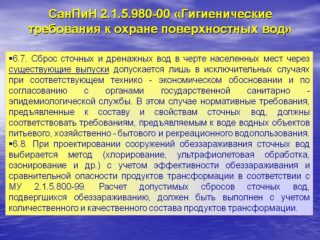 The sanitary protection of water sources from pollution is ensured by special complexes of measures established separately for the three zones.
The sanitary protection of water sources from pollution is ensured by special complexes of measures established separately for the three zones.
The territory of the first belt must be provided:
- security;
- fencing;
- paved walkways;
- landscaping, with the exception of tall trees;
- drainage system for the removal of surface water from a source of water supply outside the zone;
- connecting to a centralized sewerage network, and in its absence, hermetic drives located outside the fence, which are serviced by the sewage service as necessary.
On this site, any construction, permanent residence of people, bathing and washing, grazing, the use of fertilizers, poisons, chemicals, detergents is prohibited.
The following measures are carried out in the ZSO of the second belt:
- grouting - plug with a protective pillow made of cement, clay or molten plastic - inoperable wells, to isolate the aquifer from the penetration of contaminants of a chemical or microbiological nature;
- allowed: water tourism, fishing, construction of comfortable settlements, industrial enterprises, agricultural facilities, provided with sewage and water supply systems;
- prohibited: deforestation, the creation of filtration or irrigation systems, the development of mineral deposits, the use of toxic chemicals or fertilizers, the construction of warehouses for fuels and lubricants, livestock farms, landfills for solid or liquid household waste on the surface, as well as underground.
The measures in the third zone basically coincide with the second, but it additionally allows logging, the use of chemicals authorized by the sanitary and epidemiological surveillance to clean the reservoirs or drainage canals of vegetation and bottom sediments.
A restrictive measure common to belts is a ban on the placement on their territory of cemeteries, cattle cemeteries, pits for storing manure or silage.
Compliance with sanitary norms and rules is mandatory both for individuals and for representatives of large and small businesses.
